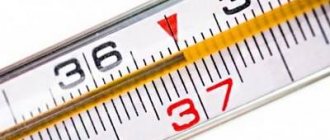Every mother panics at the slightest sign of a rise in temperature in her child. When such a temperature not only rises, but also lasts for a long time, then in this case many different ideas arise on how to help the baby. The most important thing that parents should know is that they should never give their baby medications if they are not sure of the diagnosis. Let us pay attention to the question of what constitutes a high temperature in a child, what to do if hyperthermia has manifested itself for 6 days in a row, as well as the features of providing assistance at home.
What should a child's temperature be?
Body temperature is an unstable value, which is especially important for a child’s body. Its fluctuations are acceptable throughout the day, which is influenced by various factors:
- the child's condition;
- age;
- temperature indoors or outdoors where the child is;
- meal time.
The following temperature indicators in children are distinguished:
- Reduced, in which case the thermometer will show a value below 36 degrees.
- Normal. These values range from 36 to 37, and for infants up to 37.4 degrees.
- Increased. It, in turn, is divided into subfebrile (37-38 degrees) and febrile (38 and above).
Low-grade fever in a child under one year of age is normal, so if there are no signs of illness, then parents have nothing to worry about. If the temperature is 37 in a child over 5 years old, then you need to think about the fact that he is developing a disease.
Before judging that a child’s temperature of 37 indicates illness, it is necessary to carry out the measurements correctly. Let us find out in more detail what methods exist for measuring temperature in children.
What is high temperature
Body temperature is an indicator of the body's thermal state. The normal body temperature of a healthy adult is 36.6 degrees, which everyone knows. Few people know that in children under the age of 1 year, normal temperatures are considered to be in the range from 36.2 to 37.4 degrees. In children over 1 year of age, normal temperature readings correspond to the range from 36.4 to 37 degrees.
It is important to know! Each child has an individual normal temperature, but after 3 years, the thermometer readings should correspond to 36.6 degrees.
A high temperature is a thermometer reading that exceeds 38.5-39 degrees. At this temperature, you should resort to antipyretic drugs to prevent the development of serious complications. Often a child may have a high fever for 6 days. What does this thermometer reading indicate? We'll find out more about this later.
Where to measure a child's temperature
The traditional method of measuring a child's temperature is to place the thermometer under the armpit. It is not difficult to measure the temperature of a child over 2-3 years old in this way, but what about infants? Infants can also take thermometry measurements under the armpit, but the procedure must be carried out during a period of time when the baby is sleeping.
It is important to know! To obtain the most reliable thermometry information, it is necessary to take measurements while the child is sleeping. The exception is the period of time when the baby is breastfeeding and at the same time sleeping.
In addition to axillary thermometry measurement, the following options exist:
- In the oral cavity. Oral temperature is usually 0.5-1 degree higher than the axillary measurement.
- In the rectum. Rectal temperature is 1-1.2 degrees higher than the axillary temperature. To measure it, you should use a special electronic thermometer.
- In the ear. Children often have their ear temperature measured, which allows for the most accurate thermometry information to be obtained. To take measurements, you need a special thermometer, which is inserted into the ear canal for a few seconds.
If, after the parents have measured the child’s temperature, doubts arise, it is better to take the measurements again after some time. Very often, parents begin to panic, although they did not measure the temperature correctly.
It is important to know! To make sure whether the child is healthy or sick, you need to call a doctor or go to a hospital, where all assumptions will be dispelled.
Pros and cons of rising temperatures
High temperature does not always lead to negative consequences. It is necessary for:
- suppressing the reproduction of viruses and reducing their resistance to drugs;
- strengthening phagocytosis and activating the child’s own immune defense;
- stimulation of the production of interferon, a substance that helps destroy the influenza virus;
- reducing physical activity and saving energy.
These positive effects are especially important at the initial stage of the disease. If a child’s high temperature lasts for a long time, its harm manifests itself:
- the load on the heart, kidneys, liver, stomach, pancreas increases;
- The functioning of the nervous system, in particular the brain, deteriorates.
In order to prevent serious consequences and successfully overcome the disease, it is important to know when and how to reduce a child’s temperature.
Causes of low-grade fever in children
Now let’s look at all the possible reasons why a child’s temperature remains at 37-37.5 degrees for the fifth day. If the child’s hyperthermia remains at 37-37.5 degrees for several days, then you should not resort to the use of antipyretics.
It is important to know! You can only bring down febrile body temperature when the thermometer shows 38.5-39 degrees.
Correct measurement
The first reason that a child has hyperthermia for 4 days is an error or incorrect measurement. A family with children must have at least two thermometers. To make sure that the thermometer is functioning, use another one. Only after both thermometers show the same value can a low-grade fever be judged. Most often, it is electronic thermometers that fail, so always keep a mercury device on hand.
You should also not forget when measurements are taken. If the mother takes measurements of hyperthermia in the evening, the readings will be elevated, because in the evening the body temperature rises. It is better to take measurements in the morning after 10 o'clock or in the afternoon, but not after eating. You can take measurements in two ways, which will increase the chances of obtaining reliable results.
It is important to know! If parents are convinced that the baby really has a low-grade fever for more than 6 days, then it is necessary to notify the local doctor or go to the hospital.
Teething
Typically, a temperature that lasts for 4 days indicates that the baby is teething. In this case, the age of the baby must meet the following standards:
- from 3 months to 3 years, children begin to develop baby teeth, so parents should always be attentive and learn to recognize the appearance of another tooth;
- from the age of 6-7 years, milk teeth begin to fall out, and molars appear in their place;
- The process of replacing baby teeth with molars lasts up to 10-15 years.
Almost 80% of all children experience the process of teething with the occurrence of elevated temperature, which is an absolutely normal physiological phenomenon. Another 10% of children endure the process of teething very difficult, so such children suffer from an increase in hyperthermia to febrile levels. And only 10% of children tolerate the phenomenon of teething quite easily, even without fever.
It is not difficult to determine the signs of teething in children; all you need to do is look into the child’s mouth. If there are signs of redness and swelling of the gums, as well as excessive salivation, then the reasons for low-grade fever are clear. When teething, babies pull any objects into their mouths, which can lead to the penetration of pathogenic microbes into the body. The consequence of such unauthorized entry will be the development of an inflammatory process, which will lead to febrile hyperthermia.
It is important to know! When teething, you can reduce the fever if the thermometer readings display a value above 38.5 degrees.
Overheating of the body
The temperature may persist for the fourth day due to overheating of the body. This is especially true if the temperature conditions where the baby is located are not met. The optimal temperature in the room where the baby is located should correspond to the norm from 18 to 22 degrees. If the room is very hot, the baby may develop low-grade fever for a long time.
Parents often try to dress their children warmly, hoping that in this way they are protected from the influence of negative factors. Children need to be dressed according to the weather, and if parents do not take this rule into account, then the consequence can be not only overheating, but also a cold due to excessive sweating. If the temperature remained at a subfebrile level for a long time, but when the child fell asleep, its value returned to normal, then there is no reason to panic. Prolonged exposure to the sun or in a hot room, active games, excessive wrapping of the child - all these are signs that the baby is overheated. To check whether the baby’s body is really overheated, you should remove warm clothes from it or move it to the shade. In this case, the thermometer readings will normalize within 1-2 hours, which will mean the presence of signs of overheating.
It is important to know! Overheating of the body is not as dangerous as heatstroke or sunstroke, in the presence of which the baby may lose consciousness. Monitor the condition of your little one to prevent the development of serious complications.
Reaction to vaccination
The temperature cannot last for 4 days due to a reaction to the vaccine, so if parents have suspicions, it is better to consult a doctor. From the moment of birth, all children are subject to mandatory vaccination. Some vaccines are simple and harmless, but there are also those that cause a response in the body. Most often, such reactions manifest themselves in the form of low-grade fever, which lasts no more than 2 days. This is a normal reaction of the body to the vaccine, so parents should not worry.
It’s another matter when the baby’s temperature lasts four days after vaccination. This can only mean that at the time the vaccine was administered, the child contracted a virus or infection. Hyperthermia is a sign that the body is trying to overcome pathogenic microorganisms. If hyperthermia lasts 6 days or more, then you need to inform your doctor. The body may need help in the form of antiviral or antibacterial drugs, but only as prescribed by a specialist.
Low-grade fever in children due to various ailments
The above signs can also include allergic reactions, but to determine them you will need to carefully monitor the baby. If symptoms of redness, swelling, fever, and increased mucus from the nose and mouth are detected, then the cause is most likely an allergic reaction. If all of the above signs are excluded, then the worst options should be considered - various diseases. Only a specialist can diagnose illnesses, so parents should not try to make a diagnosis on their own, much less prescribe treatment. Let's consider what kind of diseases provoke a temperature in children within the range of 37-37.5 degrees.
- Infectious diseases of the respiratory system. Most often, it manifests itself in the form of a disease such as ARVI. With the development of this disease, symptoms of a runny nose and cough appear after 1 day. If the acute form of ARVI becomes chronic, then the child may have a low-grade fever not only for several days, but also for months. Usually, a low-grade fever is used to determine the presence of serious respiratory diseases, such as tuberculosis.
- Infectious ailments of the kidneys and urinary organs. If a child has inflammation of the bladder, the temperature may persist for the sixth day or more. During the day the temperature may drop, and in the evening it can rise again to 37.5 degrees. Infectious diseases of the kidneys and urinary organs include diseases such as cystitis and pyelonephritis. It is in the presence of low-grade fever that these types of diseases can be identified.
- Infectious diseases of the gastrointestinal tract. If a child has a fever and a stomach ache, then it is necessary to look for the cause in the digestive system. Here, exacerbations of diseases such as gastritis, ulcers, poisoning, and intestinal infections may occur. Infectious diseases of the gastrointestinal tract manifest themselves in the form of diarrhea and vomiting.
- Ailments of the cardiovascular system. This condition is especially relevant for children who were born with pathologies of the heart and vascular system. Children with congenital pathologies of the cardiovascular system require special attention and care.
- Children's infectious diseases. Low-grade fever in children can be caused by an exacerbation of infectious childhood diseases such as chickenpox, rubella, and measles. Signs of these ailments are a rash all over the body, which most often occurs on the 2-3rd day.
In order to exclude the above-mentioned ailments, you should visit a doctor. If the cause of the disease is determined in a timely manner, it will be much easier to eliminate it than when the disease enters the acute stage.
In conclusion, it is important to note that despite the insignificance of a temperature of 37-37.5 degrees, you should promptly respond to its occurrence in a child. It is better to exclude serious pathologies immediately than to carry out long-term treatment later.











